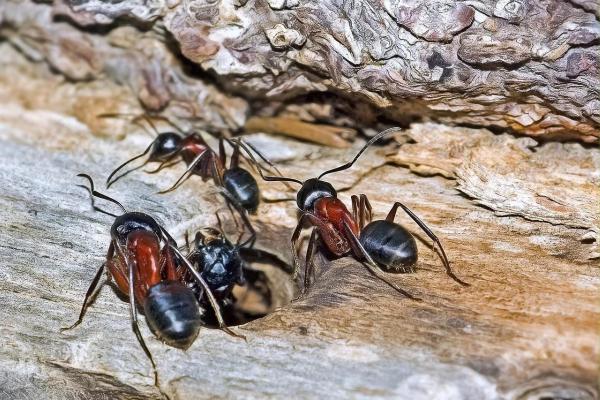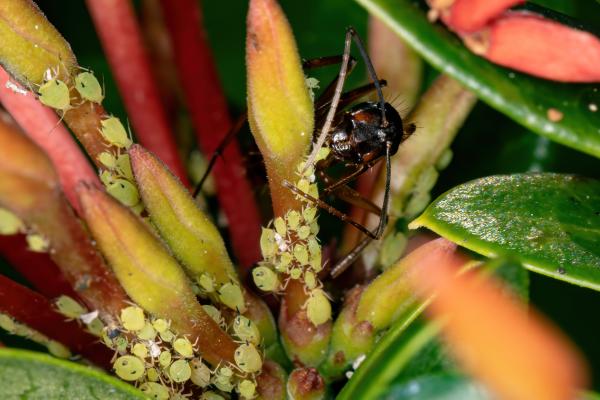Among the many species of ants found in nature, wood ants are among the most common. Named for their ability to chew through wood to build their nests, these ants are often mistaken for termites. Although they are important members of many ecosystems, they can become a nuisance in human environments. In this article, we explore the characteristics, habitat, diet, and reproduction of wood ants, and offer practical, non-lethal methods for keeping them away from your home.

Wood ants belong to the Camponotus genus, with Camponotus cruentatus being one of the better-known species. Like other ants, they have a segmented body structure and live in complex social colonies. Their most notable characteristics include:
Large body size, ranging from 1 to 2.5 cm in length — larger than many other ant species.
Distinct L-shaped antennae used for navigation and communication.
High-set antennae bases, located on the lower part of the head near the clypeus.
Lack of metapleural glands on their hind legs — a common gland in other ants that secretes antibacterial substances.
Polymorphism: individuals within the same colony can vary in size, especially among worker ants.
Coloration: most wood ants are black, but some may be brown or reddish.
High diversity: over 1,000 species have been identified, each with variations in mandibles, clypeus shape, color, or head size.
Wood ants are named for their preference to nest inside wood, especially decaying or damp material. In the wild, they commonly burrow into:
Fallen tree trunks and branches
Tree stumps or rotting logs
Hollow tree crowns or cavities in live trees
Dead or dying plant stems
In human environments, they look for:
Damp wooden structures (floors, roofs, frames)
Attics, walls, or ceilings with poor ventilation
Kitchens and bathrooms where humidity is high
Wood ants are mainly arboreal (tree-dwelling) and have a cosmopolitan distribution, especially in tropical and subtropical regions. Due to their wide variety, different species are adapted to distinct ecosystems around the globe.

Wood ants are omnivorous, but they are particularly fond of sugary substances. Their diet includes:
Honeydew produced by aphids, mealybugs, and whiteflies
Nectar from flowers
Overripe fruits or sap
Small insects or insect remains for protein
They forage both day and night, often using the same paths repeatedly, forming visible “ant trails” on walls, trees, or floors.
The wood ant life cycle includes four main stages:
Egg Stage
Cream-colored, rice grain-shaped eggs about 3 mm in length
This stage lasts around 24 days
Larva Stage
Legless and helpless; solely focused on feeding
Lasts approximately 20 days
Fed and cared for by worker ants
Pupa Stage
Encased in a protective cuticle during transformation
Does not eat; lasts about 21 days
Undergoes metamorphosis into an adult ant
Adult Stage
Includes queens (fertile females), workers (sterile females), males (drones), and young princesses
Each caste plays a specific role within the colony
The entire life cycle from egg to adult takes about 60 days, though environmental conditions like temperature and humidity can affect timing.

The reproductive process in wood ants can be broken down into two main phases:
During late spring or early summer, new queens and males develop wings and leave the colony for nuptial flights:
Males mate with queens mid-air and then die
Fertilized queens land, shed their wings, and search for a suitable nest site
In the beginning, the queen lays eggs and personally cares for the first batch of larvae
Once the first worker ants emerge, they take over the tasks of feeding and protecting the brood, allowing the queen to focus solely on egg-laying.
When the colony reaches around 2,000 worker ants, the queen begins producing new males and princesses, which will eventually leave the nest for future nuptial flights, starting the cycle again.

While wood ants play a vital role in nature, their presence in homes — particularly in wooden structures — can cause significant damage. If you discover or suspect an infestation, here are eco-friendly and humane methods to deter them:
Remove damp or rotten wood: Wood ants prefer damaged or moist wood for nesting.
Seal cracks and crevices: This prevents ants from entering or nesting within walls or foundations.
Keep your home clean and dry: Good ventilation and cleanliness can disrupt ant colonies and prompt them to relocate.
Use natural repellents:
Mix water with vinegar, lavender essential oil, or clove pieces and spray along ant trails
Soak orange peels in water overnight to extract their aroma, then spray it in affected areas
Store firewood away from your house: Prevents wood ants from moving indoors
Keep kitchen counters free of sugary residue: Cuts off their food source
Ant Bite Warning: If bitten by a wood ant, it may cause mild pain or swelling, but it is not dangerous. Clean the bite area with soap and water to prevent infection.
If you'd like to learn more about ants and other wild insects, check out our Wildlife category for more educational content and species profiles.
Bibliography
Ayala, V., & David, A. (2018). Carpenter ants of the genus Camponotus (Hymenoptera: Formicidae) in the urban tropical dry forest of Santa Marta Magdalena, Colombia. Bachelor's thesis, Universidad del Magdalena.
Iberian Association of Myermecology (n.d.). Genus Camponotus. Available at: http://www.hormigas.org/xGeneros/Camponotus.htm
animal tags: Wood ants
We created this article in conjunction with AI technology, then made sure it was fact-checked and edited by a Animals Top editor.